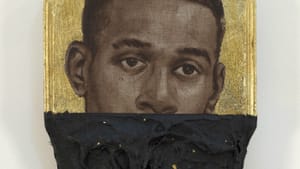Stay in the Loop
BSR publishes on a weekly schedule, with an email newsletter every Wednesday and Thursday morning. There’s no paywall, and subscribing is always free.
Haverford exhibition confronts racial terror and celebrates its healers

The Legacy of Lynching: Confronting Racial Terror in America, a new exhibit and symposium at Haverford College, probes the connection between the extrajudicial mob violence against African Americans during the Jim Crow era and the continuation of that system of racial control up to the present day through the justice system itself.
While the topic is deeply disturbing, the exhibit is energizing and inspiring, thanks to an impressive selection of contemporary artists with short videos, archival materials, and an emphasis on antiracist activism.
A piece of the Equal Justice Initiative
Lindsey Reckson, a faculty member at Haverford College and organizer of the show, explained the challenge of mounting the exhibit: “How do you engage viewers without reproducing the terrorism of that history?”
The exhibit was developed in collaboration with the Equal Justice Initiative, a nonprofit research and advocacy organization based in Alabama that challenges mass incarceration. EJI has documented over 4,000 lynchings between 1877 and 1950, and established the National Memorial for Peace and Justice, which opened earlier this year.
Reckson, who teaches American and African-American literature and visual studies at Haverford, approached EJI after she saw a small exhibit about its work in a gallery in Chelsea, New York City, a few years ago. The Brooklyn Museum subsequently mounted a larger exhibit, including artwork from its collection. The Haverford show is the first stop in a traveling version of the Brooklyn Museum’s show, featuring all new artwork and with archival materials specific to the Delaware Valley.
“Our gallery staff is great about supporting faculty, so I was invited to create an exhibit that complements my classes. Students learn through the exhibit and extra readings, and also explore the work of the artists.”
Kalia Brooks Nelson, an independent curator who teaches at New York University’s Tisch School of the Arts, selected the artwork by Josh Begley, Alexandra Bell, Sonya Clark, Ken Gonzales-Day, Ayana V Jackson, Titus Kaphar, Glenn Ligon, Lorna Simpson, and Hank Willis Thomas.
Testifying to the terror and the activism
Reckson’s course includes the journalist Ida B. Wells, who began documenting lynchings in 1892 upon the murder of her friend Tom Moss in Memphis, Tennessee. Wells is highlighted in the exhibit, which includes a pamphlet she published in 1894, A Red Record: Tabulated Statistics and Alleged Causes of Lynching in the U.S. Two local anti-lynching documents, published in the early 1900s by the Religious Society of Friends, are from the college’s Quaker archives.
“My course about the cultural history of the death penalty includes how artists have responded to that issue,” said Reckson. “EJI makes a strong case for how lynching moved into our criminal justice system, with the lynch mob transformed into law-enforcement officials. It’s important to not only testify to the terrorism of lynching but also to testify to antilynching activism.”
The Legacy of Lynching: Confronting Racial Terror in America runs at Haverford College’s Cantor Fitzgerald Gallery through December 16. On Friday, November 16, from 9am to 5:30pm, Haverford hosts a special symposium titled The Legacy of Lynching: Art and Practice. And the Haverford campus’s Visual Culture, Arts, and Media facility hosts an associated exhibition, The Lynching of Zachariah Walker: A Local Legacy (running through November 23), about a 1911 lynching in nearby Coatesville, Pennsylvania. All events are free and open to the public. Visit online for the schedule, speakers, and more information.
Sign up for our newsletter
All of the week's new articles, all in one place. Sign up for the free weekly BSR newsletters, and don't miss a conversation.

 Kathryn Smith Pyle
Kathryn Smith Pyle